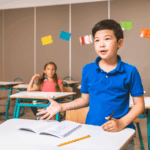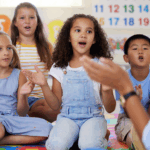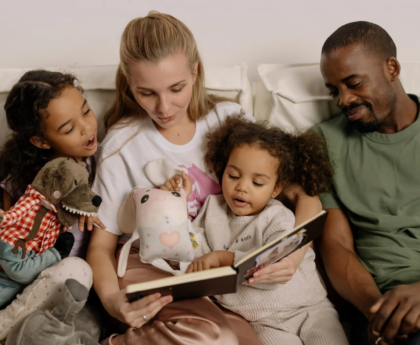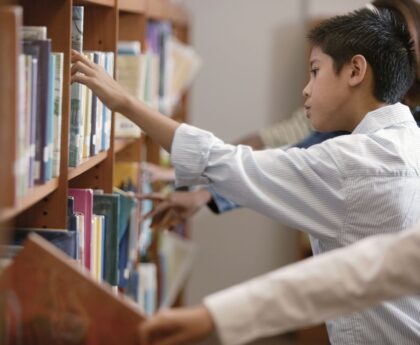Open a Jan Brett book, and you enter a world where the story unfolds in multiple places all at once. While the main text tells you what’s happening now, the decorative borders whisper secrets about what’s coming next. A child who learns to read these visual clues develops prediction skills that transform their reading comprehension forever.
Jan Brett’s books are masterpieces of visual storytelling. Her elaborate illustrations don’t just decorate the page. They teach children to observe carefully, make predictions, and understand that stories can be told through pictures as powerfully as through words. Brett’s books offer a perfect gateway for parents seeking ways to build their child’s reading comprehension.
How Jan Brett’s Border Illustrations Work Their Magic
Jan Brett’s signature style includes elaborate border illustrations that run parallel to the main story. In “The Mitten,” while the text describes animals climbing into a lost mitten, the borders show which animal is approaching next. Children can predict who will arrive before the text reveals it.
This design is brilliant for teaching prediction. The borders give children information slightly ahead of the main narrative. A child looking carefully at the pictures knows something the characters don’t know yet. This creates delicious anticipation and rewards careful observation.
In “The Hat,” the borders show what Hedgie the hedgehog is about to encounter, while the main illustrations show his current situation. Children who track both stories simultaneously develop sophisticated visual literacy skills. They learn to hold multiple threads of information in mind, which is exactly what good reading comprehension requires.
The borders also provide context and backstory. In “Gingerbread Baby,” the borders show what’s happening in other parts of the house while Matti creates his escape plan. This gives children a fuller understanding of the story world and helps them make better predictions about how events might unfold.
Brett’s illustrations reward multiple readings. The first time through, children focus on the main story. On subsequent readings, they discover new details in the borders. They notice small animals, changing seasons, or recurring visual jokes. This teaches them that careful observation always reveals more information.
The detailed, realistic style of Brett’s artwork also teaches children about the natural world. Her animals are anatomically accurate. Her settings reflect real places and cultures. Children absorb information about animal behavior, traditional clothing, and different landscapes while enjoying the story.
Build Prediction Skills With Specific Jan Brett Titles
“The Mitten” is perfect for introducing prediction to young children. The repetitive structure means children quickly grasp the pattern. Each new animal wants into the mitten. The borders clearly show who’s coming next. Even preschoolers can predict successfully, which builds their confidence as story-readers.
After reading partway through, pause and ask your child who they think will arrive next. Point to the border illustrations for clues. Celebrate when their prediction matches what happens. If they predict something different, talk about why the actual event makes sense within the story.
“The Hat” offers slightly more complex prediction opportunities. Hedgie puts on a sock that fell from a clothesline, thinking it’s a hat. Other animals laugh at him. The borders show each animal about to discover their own “hat” from the clothesline. Children can predict that each mocker will end up in a similar situation.
This book teaches prediction about character behavior and story patterns. Once children see the pattern of animals mocking Hedgie, then finding themselves in the same position, they predict it will happen with each new character. They’re learning about recurring story structures.
“Gingerbread Baby” adds another layer of prediction complexity. Children familiar with the traditional Gingerbread Man story bring that knowledge to their predictions. But Brett’s version has a twist. The borders show Matti building something, which hints at the surprising ending. Children must integrate multiple sources of information to make accurate predictions.
“The Mitten” also works beautifully for teaching story climax and resolution. As more animals crowd into the mitten, tension builds. Children can predict that something will eventually go wrong. When the bear sneezes and the mitten explodes, it confirms their prediction while providing a satisfying story conclusion.
Visual Literacy Skills That Transfer to Reading
Visual literacy means understanding and creating meaning from visual images. For young children, this skill develops before and alongside reading literacy. The ability to interpret pictures supports and enhances text comprehension.
Jan Brett’s books teach children to look carefully at illustrations for information. They learn that pictures contain clues about setting, character emotions, and upcoming events. This habit of careful observation transfers directly to reading comprehension strategies.
When children learn to use picture clues in Brett’s books, they develop skills they’ll use with all illustrated texts. They learn to notice character facial expressions that reveal emotions not stated in text. They observe background details that provide context. They track visual continuity across pages.
These visual literacy skills become reading comprehension skills. A child who learned to predict story events from Brett’s border illustrations will look for foreshadowing clues in text. A child who learned to notice character expressions in illustrations will infer character feelings from descriptive words.
Brett’s detailed illustrations also teach children about visual storytelling across cultures. Her books often feature traditional clothing, architecture, and customs from specific cultures. “The Mitten” reflects Ukrainian culture. “Mossy” includes Victorian-era details. Children learn that stories exist within cultural contexts.
The sequential nature of Brett’s border illustrations teaches visual narrative structure. Children see how one event leads to another. They understand cause and effect through pictures. This prepares them to track plot development when they read chapter books without illustrations.
Practical Ways to Use Jan Brett Books at Home
Start by reading through a Jan Brett book once without stopping to discuss the borders. Let your child enjoy the main story first. On the second reading, pause to examine the border illustrations. Ask what they notice and what they think might happen next.
Make prediction a game. Before turning each page, look at the borders and ask your child to predict what will happen in the main illustration. After turning the page, celebrate correct predictions and talk about surprising developments.
Cover the main text and illustrations with your hand, showing only the borders. Ask your child to tell the story based solely on the border pictures. This builds their visual storytelling skills and proves they can construct a narrative from images alone.
After finishing a Brett book, encourage your child to create their own border illustrations for a familiar story. They might draw borders showing what happens next in “The Three Little Pigs” or “Goldilocks.” This creative activity reinforces their understanding of how visual prediction works.
Compare Jan Brett books to books without elaborate borders. Discuss how the reading experience differs. Help your child articulate that Brett’s borders give special information that makes prediction easier and more fun.
Use Brett’s books to teach your child to support their predictions with evidence. When they predict what will happen next, ask them to point to the visual clues that led to their prediction. This teaches them to base predictions on evidence rather than random guessing.
Read the same Brett book multiple times over several weeks. Each reading, your child will notice new details in the illustrations. This teaches them that careful, repeated reading always reveals more information. It’s a lesson that applies to all reading.
Beyond Prediction: Other Literacy Skills in Brett’s Books
While prediction and visual literacy are Brett’s special strengths, her books teach many other important reading skills. Her texts often feature rich vocabulary in context. Words like “trampled,” “trudged,” and “burrowed” appear in situations where illustrations help children understand their meaning.
The repetitive structures in many Brett books support early reading development. Repeated phrases give children anchor points they can read independently. The predictable patterns build confidence while teaching story structure.
Brett’s books also model fluent reading. When you read them aloud with expression, emphasizing the rhythm and repetition, you demonstrate how fluent readers sound. Your child internalizes these patterns, which supports their own reading fluency development.
Many Brett books feature strong story elements that teach narrative structure. Clear settings, distinctive characters, obvious problems, and satisfying resolutions help children understand how stories work. This knowledge transfers to their comprehension of all narratives.
The cultural elements in Brett’s books build background knowledge. When children later encounter texts about different cultures or time periods, they bring relevant context from these richly illustrated stories. Background knowledge is one of the strongest predictors of reading comprehension.
Create Lifelong Readers Through Beautiful Books
Jan Brett’s books prove that beautiful, thoughtfully designed books enhance literacy development. When children experience books as treasures full of discovery, they develop positive associations with reading. These emotional connections matter as much as skill development.
A child who learns to read Jan Brett’s visual clues develops observation skills that serve them throughout life. They learn that information comes in multiple forms. They practice integrating different types of information into a coherent understanding. These are sophisticated cognitive skills presented in accessible, delightful packages.
The prediction skills children develop with Brett’s books transfer to all their reading. They approach texts with an active, questioning mindset. They look for clues about what might happen next. They confirm or adjust their thinking as they read. These habits define strong readers.
Start Building Visual Literacy Today
Jan Brett’s books offer a perfect entry point for teaching prediction and visual literacy. Combined with systematic phonics instruction, these comprehension strategies help children become complete, confident readers who decode accurately and understand deeply.
Start your 7-day free trial and give your child the foundation they need to fully enjoy and learn from beautiful books like Jan Brett’s treasures.





